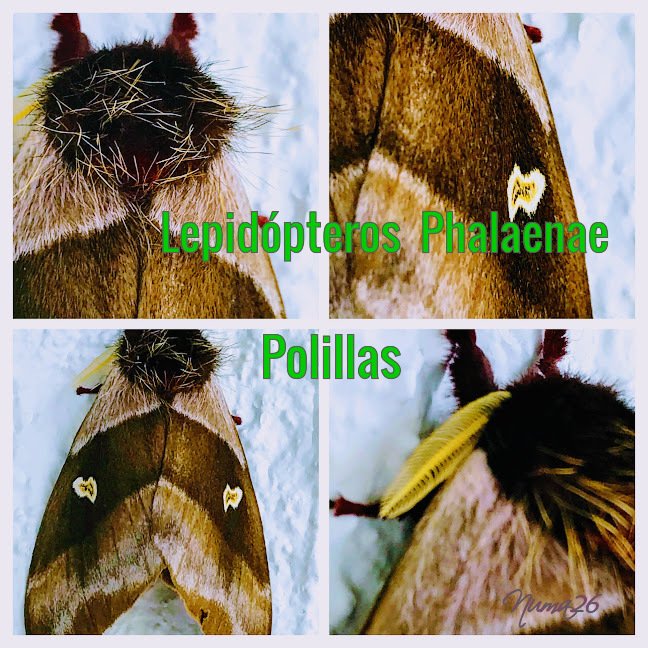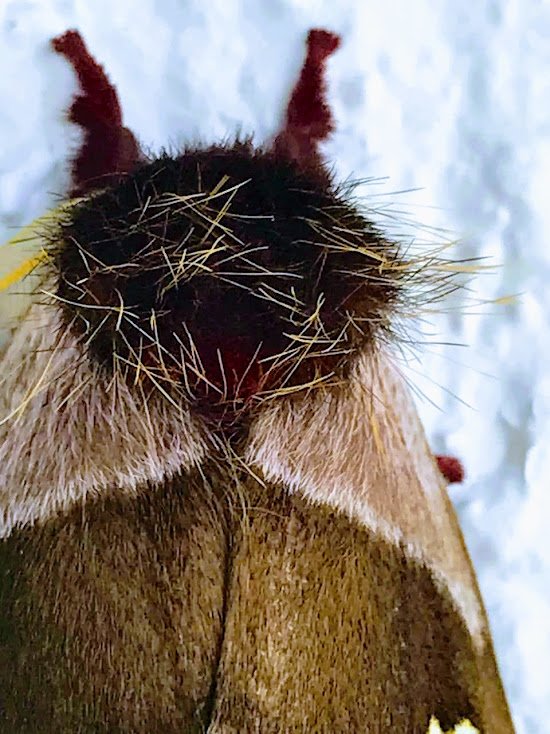The beautiful Moth / La hermosa Polilla/[Eng - Esp]
Friends of Insects Of Word. I have decided to introduce you to the most beautiful model I have ever seen, a Moth! The wonderful thing about all this, is that I dedicated myself to check Google carefully to see if I could get any similar and to my satisfaction, none of the ones I managed to observe, looks like her. Of course it has the characteristics of all moths, but my excitement is that my beautiful friend is not common. At least its beautiful color and tones.
Amigos de Insects Of Word. He decidido presentarles a la modelo más hermosa que he visto. ¡Una Polilla! Lo maravilloso de todo esto, es que me dediqué a revisar en Google con detenimiento para ver si conseguía alguna similar y para mi satisfacción, ninguna de las que logré observar, se parece. Claro que tiene las características de toda polilla, pero mi emoción estriba en que mi bella amiga, no es común. Al menos su hermoso color y tonos.


According to the group of insects, the moth in question is of the order Lepidoptera Phalaenae (Lepidoptera, meaning "wings with scales"). (Lepidoptera, which means "wings with scales") is very diverse and abundant in the world. The larvae or caterpillars are herbivorous, and when they are adults, they feed on nectar, being pollinators par excellence. (Relationship where two species involved mutually benefit each other).
In Venezuela, specifically in the east of the country, there is a type of moth, "Palometa Peluda" (Hylesia metabus), so called because it has scales or stinging hairs that cause dermatitis and allergic reactions in humans. These appear seasonally.
The moth that I show you, Lepidoptera Phalaenae, is native to the mountains of the Vargas Municipality, specifically El Junquito. This is a particularly cold area, where strawberries, apples, figs, etc. are abundant. This type of moth feeds on the nectar of its flowers.
De acuerdo al grupo de insectos , la polilla que nos ocupa, es del orden Lepidópteros Phalaenae. (Lepidoptera, que significa «alas con escamas») Es muy diverso y abundante en el mundo. Las larvas u orugas, son herbívoras, y cuando son adultos, se alimentan de néctar, siendo polinizadores por excelencia. (Relación donde dos especies involucradas se benefician mutuamente).
En Venezuela específicamente en el Oriente del país, existe un tipo de polilla, "Palometa Peluda" (Hylesia metabus) llamada así, por poseer escamas o pelos urticantes que causan dermatitis y reacciones alérgicas al humano. Estas aparecen por temporadas.
La polilla que les muestro, Lepidóptero Phalaenae, es oriunda de las montañas del Municipio Vargas, específicamente El Junquito. Zona particularmente fría, donde abunda la siembra de fresas, manzanas, higos etc. Este tipo de Polilla, se alimenta del néctar de sus flores.


The previous image, for me, was of great significance, because my "model" stayed still while I took some shots. This photo, captured with my "IPhone 6", impressed me because I could observe very closely her little head from above, and enjoy seeing those little candy-colored hairs that moved with the breeze, inviting me to touch them to feel the sensation of softness that they appeared.
La anterior imagen, para mi fue de gran significado, porque mi "modelo" se quedó quietecita mientras le hacía algunas tomas. Esta foto, capturada con mi "IPhone 6", me impactó puesto que pude observar muy de cerca su cabecita por encima, y disfrutar viendo esos pelitos color caramelo que con la brisa se movían, invitándome a tocarlos para sentir así, la sensación de suavidad que aparentaban.


Moths and butterflies look similar, especially in their physical appearance, some features are different between them, for example, butterflies have very bright colors, moths are pastel colors, white, gray, opaque, brown, black, etc.. That is, shades if you will uncommon in a butterfly. Also in this image, taking advantage of the peace that my beautiful moth professed to me, I took a shot of its right wing, and as a curious thing mentioned before, I could not get any with that particular spot that looks like a beautiful tattoo. They have tiny scales so well placed that they form such a perfect pattern of colors on their wings, if you get close with a magnifying glass, you can differentiate each color. It's impressive! Some of them even have the shape of a human eye.
Las polillas y las mariposas lucen similares, sobre todo en su aspecto físico, algunas características son diferentes entre ellas, por ejemplo, las mariposas tiene colores muy vivos, las polillas son de colores pastel, blanco, gris, opacos, marrones, negros, etc. Es decir, tonalidades si se quiere poco comunes en una mariposa. Además en esta imagen aprovechando la paz que me profesaba mi linda Polilla, hice una toma de su ala derecha, y como cosa curiosa antes comentada, no pude conseguir ninguna con esa particular mancha que aparenta un hermoso tatuaje. Ellas poseen minúsculas escamas tan bien colocadas, que forman ese patrón de colores tan perfecto en sus alas, si te acercas con alguna lupa, podrías diferenciar cada color. ¡Es impresionante! Algunas tienes hasta la forma de un ojo humano.

As a final sample of this wonderful finding that Nature gives me every day, I brought you as a sample and main difference between the butterfly and the moth, another photograph of the head of my model, where you can see that moths have a plume or feather in the form of a comb, and not a filamentous antenna with the appearance of a cane. I was very amused to note that the plume, so well placed, resembled the plume of an Indian warrior.
Como muestra final de este maravilloso hallazgo que día a día me regala La Naturaleza, les traje como muestra y principal diferencia entre la mariposa y la polilla, otra fotografía de la cabeza de mi modelo, donde se puede apreciar que las polillas poseen un penacho o pluma en forma de peine, y no una antena filamentosa con aspecto de bastón. Me causó mucha gracia al notar que su pluma tan bien colocada, parecía el penacho de un indio guerrero.

I felt very comfortable studying simple but very clear data about moths. Of course at the end of this post, I put some sources or bibliography consulted to write with certainty one or another scientific information stated. The important thing is to enjoy the wonders that nature gives us and this was one of them for me. I invite you to observe from now on, with the eyes that God gave us, these specimens, which in one way or another, help to keep in balance our ecosystem and therefore the planet we inhabit.
Me sentí muy a gusto estudiando datos sencillos pero muy claros acerca de las polillas. Por supuesto al final de este post, coloco algunas fuentes o bibliografía consultada para escribir con certeza una que otra información científica enunciada. Lo importante es disfrutar de las maravillas que nos regala la naturaleza y esta para mi fue una de ellas. Los invito a que de hoy en adelante, observen con los ojos que nos regaló Dios, a estos ejemplares, que de una u otra manera, ayudan a mantener en equilibrio nuestro Ecosistema y por ende al Planeta que habitamos.

Thanks for reading my post
¡Amigos! Sigamos amando los regalos que nos da Natura.
Gracias por leer mi post

Electronic-terrorism, voice to skull and neuro monitoring on Hive and Steem. You can ignore this, but your going to wish you didnt soon. This is happening whether you believe it or not. https://ecency.com/fyrstikken/@fairandbalanced/i-am-the-only-motherfucker-on-the-internet-pointing-to-a-direct-source-for-voice-to-skull-electronic-terrorism
https://twitter.com/nuher001/status/1448069050190516232
The rewards earned on this comment will go directly to the person sharing the post on Twitter as long as they are registered with @poshtoken. Sign up at https://hiveposh.com.
Tienes razón, no es una polilla muy común, yo tampoco la había visto nunca, hiciste un gran trabajo con tu publicación. Gracias por compartir con la comunidad.
¡Oye @nicanor-mosquera! Gracias por tu apoyo y comentario. Realmente es linda y rara. Quise tomarle una foto a sus ojos, pero se me hizo muy difícil y no quise molestarla. Ella estaba hermosamente quieta. Saludos y agradecida.
Your content has been voted as a part of Encouragement program. Keep up the good work!
Use Ecency daily to boost your growth on platform!
Support Ecency
Vote for Proposal
Delegate HP and earn more
¡Gracias @ecency!
We appreciate your work and your post has been manually curated on behalf of Insects Of The World Community. It will be added to the weekly curation report. Keep up the good work.
¡Gracias por vuestro gran apoyo, y visita ! Sobre todo el estímulo a continuar. Me encanta fotografiar (Aunque no soy profesional) a los insectos. Saludos.
Great post abot the Lepidoptera Phalaenae @numa26 ^^ I aded it t the DNA library for Identified and Described Species ;)
¡Hola @adalger ! Muy agradecida por tu "deferencia" con relación a mi "bella polilla". Saludos y Éxitos en la Biblioteca ADN.